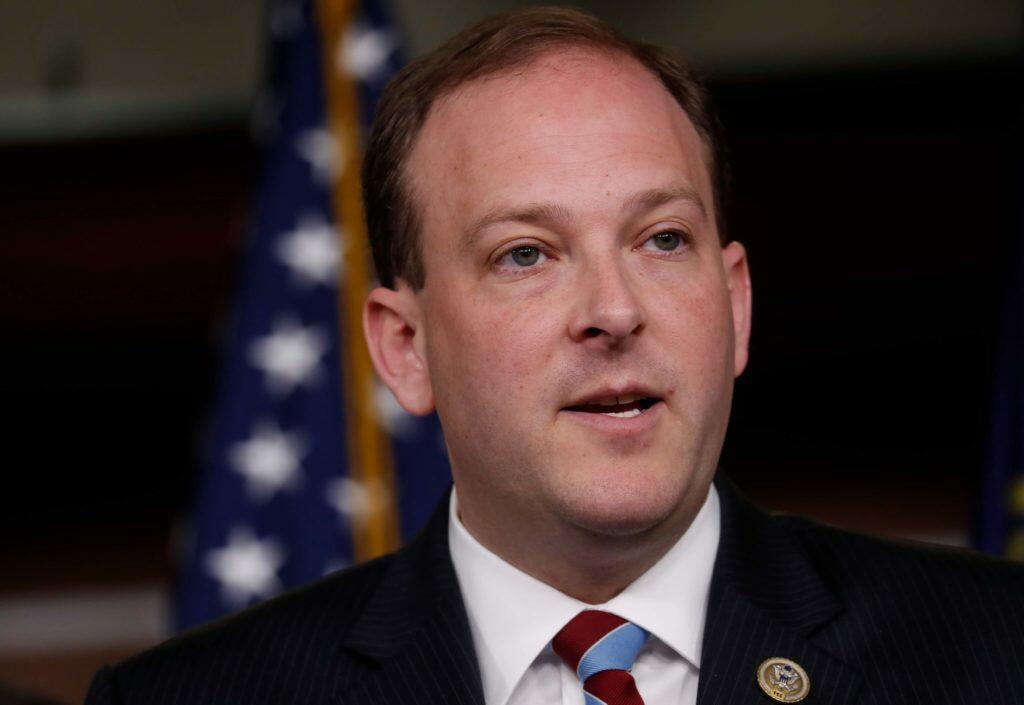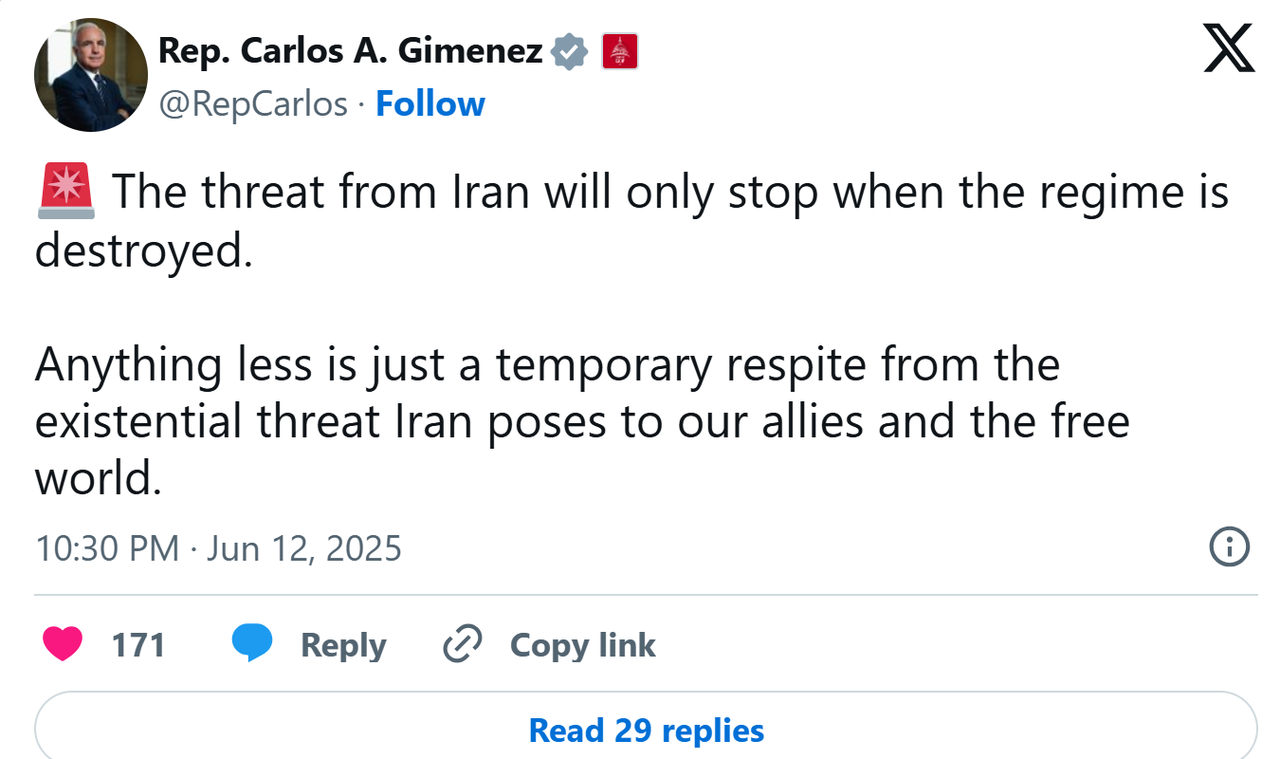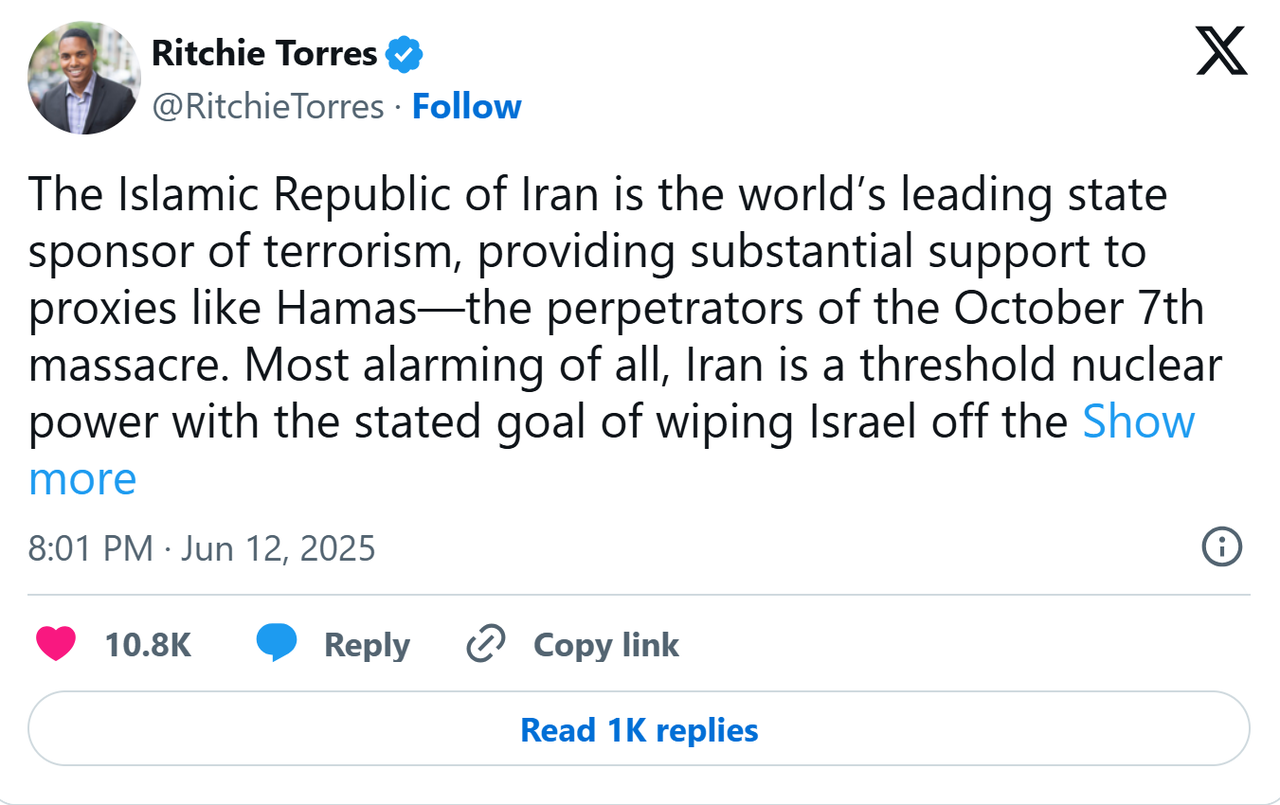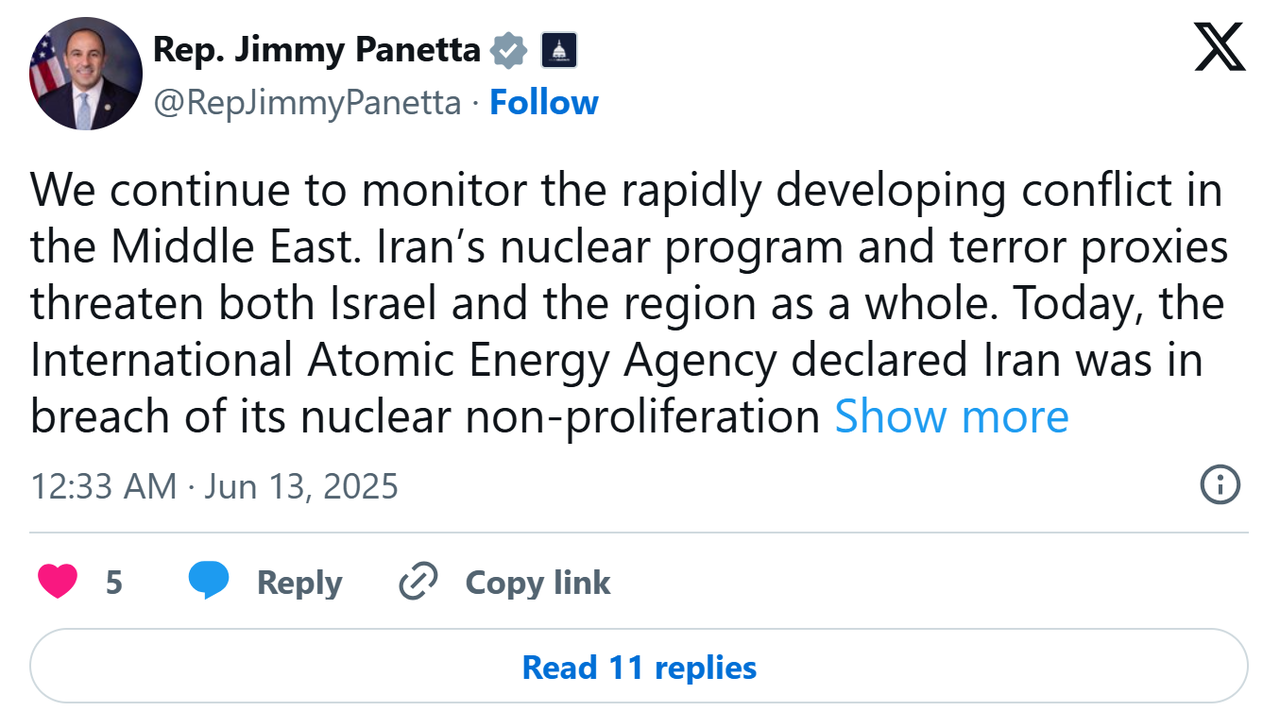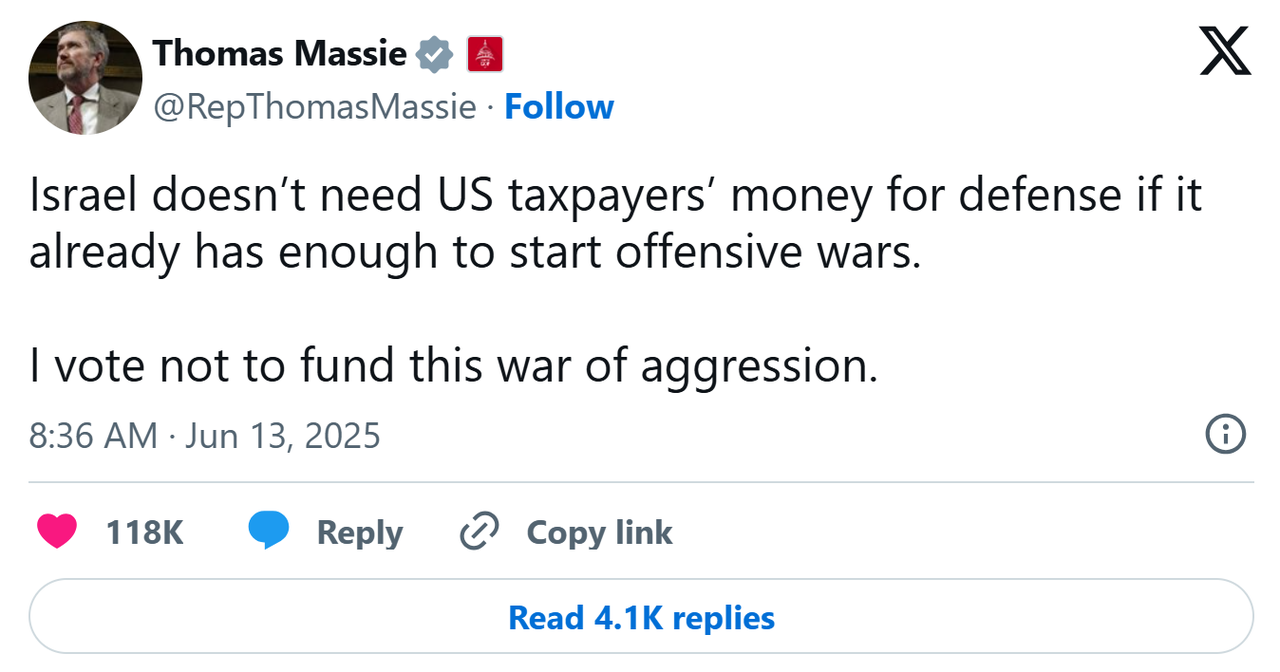https://www.youtube.com/watch?v=xcLqUPTNAao
Search This Blog
Saturday, June 14, 2025
Sabbath gasbags, June 15
NewsNation’s “The Hill Sunday,”: Former Vice President Mike Pence; Rep. Greg Landsman (D-Ohio); Director of Foreign and Defense Policy Studies at American Enterprise Institute Kori Schake.
ABC’s “This Week”: Israeli Ambassador to the U.S. Yechiel Leiter; Sen. Alex Padilla (D-Calif.); retired Gen. Joseph Votel, ex-commander of U.S. Central Command.
NBC’s “Meet the Press”: Sens. Adam Schiff, (D-Calif.) and Rand Paul (R-Ky.).
CNN’s “State of the Union”: Padilla; Los Angeles Mayor Karen Bass (D); Pence.
CBS’ “Face the Nation”: Padilla; Sens. Tom Cotton (R-Ark.), Lindsey Graham (R-S.C.), and Richard Blumenthal (D-Conn.).
“Fox News Sunday”: Sens. John Thune (R-S.D.), and Jeanne Shaheen (D-N.H.).
Fox News’ “Sunday Morning Futures”: Sen. Ted Cruz (R-Texas); Sen. John Barrasso (R-Wyo.); Rep. Darrell Issa (R-Calif.); Fox News senior strategic analyst retired Gen. Jack Keane; HRH Reza Pahlavi, exiled Iranian crown prince
China’s Biotech Moment Ignites a 60% Stock Rally That Beats AI
China’s biotechnology stocks have shaken off a four-year slump to be among the hottest performers in Asia this year and funds are tipping further gains.
The Hang Seng Biotech Index has surged more than 60% since the start of January amid investor enthusiasm over a pair of billion-dollar deals involving foreign firms licensing Chinese drugs. Share gains at two highly anticipated listings of local producers have further burnished the sector’s appeal.
Making The Power Grid Great Again
Last week, EPA Administrator Lee Zeldin announced the proposed repeal of the Biden-era’s Clean Power Plan 2.0, which ruled that coal-fired and many new natural gas power plants must capture and store over 90% of their carbon emissions by the 2030s—or shut down by 2040. It’s a costly mandate, resting on shaky legal and technical foundations. Americans would be fortunate to have it repealed.
President Biden issued his Clean Power Plan 2.0 after the Supreme Court ruled in West Virginia v. Environmental Protection Agency that President Obama’s Clean Power Plan 1.0 exceeded the Environmental Protection Agency’s (EPA) statutory authority. The Court’s 2022 decision concluded that the EPA had overstepped by attempting to reshape the nation’s energy grid without clear congressional approval.
In a world where energy security and affordability are paramount, one might assume that when the Supreme Court strikes down a sweeping environmental regulation, the EPA would reconsider its approach. But in Washington, ideology often trumps reason, and undeterred, the Biden administration returned in 2024 with a sequel that EPA now proposes to end.
The Clean Power Plan 1.0 attempted to force states to overhaul their energy systems entirely, compelling them to adopt renewable energy and shutter fossil fuel plants, regardless of local needs or economic consequences.
Its successor, the Clean Power Plan 2.0, imposed an estimated $15 billion in regulatory costs over 20 years, and greater costs through increases in prices of electricity and slower economic growth. EPA argues “that GHG emissions from fossil fuel-fired power plants do not contribute significantly to dangerous air pollution.”
Just as Chief Justice John Roberts warned in 2022 that the EPA had claimed “an unheralded power representing a transformative expansion of its regulatory authority,” the EPA was trying to do through regulation with the Clean Power Plan 2.0 what Congress had repeatedly declined to do through legislation.
Fifteen years ago similar legislative proposals—the Waxman-Markey and Kerry-Lieberman bills—failed in the U.S. Congress even when Democrats held strong majorities. That should have signaled to regulators that such sweeping changes lacked democratic legitimacy.
Yet ideology brooks no dissent, and the Biden administration’s Clean Power Plan 2.0 pressed ahead, relying on technologies that are neither commercially viable nor widely demonstrated. Carbon capture and storage, the linchpin of the Biden plan, remains prohibitively expensive and technically uncertain. Hydrogen, another favored solution, is not cost-effective. The EPA’s cost-benefit analysis glossed over these realities, assuming generous tax subsidies and benefits from reduced CO2 emissions would bridge the gap.
The consequences of this regulatory ambition are stark. The North American Electric Reliability Corporation warned in 2024 that the Biden plan’s disincentives for baseload power would destabilize the electricity grid, increasing the risk of blackouts. Spain’s recent 12-hour blackout offers a cautionary tale: rapid transitions to solar without reliable baseload power can lead to lack of backup power, causing the grid to crash.
Moreover, the Biden plan was regressive. It would raise electricity prices, disproportionately affecting low-income households, farmers, and small businesses. It would also undermine a reliable electricity grid and economic growth. By constraining energy supply and inflating costs, it would drive economic activity and jobs offshore, where goods would be manufactured with coal-fired energy in China.
The dirty secret, which Mr. Zeldin forced into the open, is that the Biden plan would not have helped the climate. The greenhouse gases emitted by the power sector do not significantly affect human health, and moving energy intensive manufacturing overseas where it is made with coal-fired power using older technology would have raised emissions, not lowered them.
There is also a deeper constitutional issue at play. The EPA is misusing its authority under the Clean Air Act to pressure states into adopting policies that lie outside its jurisdiction. The plan’s emissions targets are so stringent that no state has voted them into law.
The Clean Power Plan 2.0 amounts to a form of federal commandeering. States are faced with a loss of a significant portion of their electricity generation capacity, and their manufacturing base, by restructuring their energy systems to align with the EPA’s vision. This is not cooperative federalism; it is coercion.
And it is unnecessary. America’s carbon emissions have declined by about a billion metric tons over the past 15 years without such mandates. This progress has been driven by technological innovation, not federal diktats. Cleaner air and efficient power generation are worthy goals, but they must be pursued within the bounds of the law and with respect for democratic processes.
The lesson from West Virginia v. EPA is clear: transformative policy changes require legislative backing. Agencies cannot conjure sweeping powers from ambiguous statutes. The rule of law demands clarity, accountability, and restraint.
As America grapples to ensure grid reliability, there is a cautionary tale here. The path to a reliable energy future lies not in top-down mandates, but in innovation, cooperation, and respect for the institutions that safeguard our freedoms. Administrator Zeldin should be congratulated.
Diana Furchtgott-Roth is director of the Center for Energy, Climate, and Environment at The Heritage Foundation.
https://www.zerohedge.com/energy/making-power-grid-great-again
California Retail Theft Rose 11 Percent From 2014 To 2023: Report
by Jill McLaughlin via The Epoch Times (emphasis ours),
California’s soft-on-crime approach, along with pandemic-era actions, may have contributed to a rise in retail theft from 2014 to 2023, according to a report published by the state Legislative Analyst’s Office (LAO) on June 12.

In the report, “Retail Theft in California: Looking Back at a Decade of Change,” the LAO found that retail theft in the state rose after a slight decline during the COVID-19 pandemic, resulting in an overall increase of 11 percent during the nine-year timeframe.
Despite the statewide increase, however, the numbers reported are still below the historical highs seen in the 1980s, the report found.
“Concerns about theft from retail businesses have become more prominent in recent years,” the analyst’s office wrote in the report. “Retail theft has implications for economic outcomes, as well as a sense of safety, well-being, and fundamental quality of life for Californians.”
In 2021, nearly two in three California voters said crime in the state was getting worse, while 23 percent said it was staying the same and 6 percent said it was getting better, according to a survey conducted that year by David Binder Research.
The report finds that the statistics have fluctuated greatly in the past decade.
From 2014 and 2015, retail theft increased slightly, going up 5 percent before declining 20 percent during 2015 and 2012. Nearly half of the drop happened between 2019 and 2020, when the state was placed on lockdown during the pandemic.
“Pandemic-related factors—such as temporary stay-at-home orders and closure of nonessential retail businesses in the early part of the pandemic—likely contributed to the decline over this period,” the report stated.
After the decline, statistics show that retail crime increased by 32 percent from 2021 and 2023.
The crime numbers may not represent the full picture, however, according to the analysis.
A large portion of law enforcement agencies—representing about 10 percent of the state’s population—did not report crime numbers for some or all of 2023 when reporting methods were changed nationwide during the Biden administration..
“Accordingly, crime data may understate the actual increase in retail theft that occurred in 2023,” the report stated.
Bucking the trend were smaller counties in the state that were reporting declines in retail theft from 2019 to 2023.

“The reason for these differences is unclear but could be tied to factors such as the concentration of retail establishments in each county,” according to the report.
The analysis pointed to Proposition 47, passed in 2014, and changes in the state’s criminal justice system after 2020 as possible reasons for crime to have risen. The proposition reduced several felonies to misdemeanors, limiting the authority to arrest people for some crimes.
The public has criticized the proposition, claiming the law allowed shoplifters to walk away with up to $950 in goods, mandating law enforcement to issue a ticket to suspected thieves instead of arresting them.
“Researchers found that Proposition 47 increased larceny (a category of crime that includes some forms of retail theft), though they were unable to determine the impact on retail theft specifically,” the analyst’s office, which provides fiscal and policy advice to the state Legislature, stated in the report’s executive summary.

“Generally, research on crime rates suggests that people are less likely to commit a crime when they perceive that they have a higher chance of being apprehended,” according to the report.
The state also changed several crime policies in response to the COVID-19 health crisis, including releasing convicted criminals early from prison, implementing zero-bail policies, and reducing probation term lengths.
“[Researchers] found that pandemic-era changes to the criminal justice system increased nonresidential burglary (a measure of some forms of retail theft) by reducing jail populations and the likelihood of arrest,” according to the LAO. “However, the researchers were only able to explain about one-third of the pandemic-era increase in nonresidential burglaries.”
The findings suggested that factors outside the criminal justice system, such as changes in the retail environment, also likely contributed to retail theft trends in California.
Possible changes to the retail environment may also have affected retail theft rates, the report said. For example, many stores have expanded shelf-checkout lines and store policies that direct staff not to physically confront shoplifters.

Pandemic-era changes, such as the use of protective face masks that could also be used to conceal identities, may have further emboldened shoplifters, according to the analysis.
The report also stated that a change in societal factors, such as homelessness prompting the stealing of necessities like food, and increased drug use disorders, could have impacted retail theft rates.
Voters responded last year to the state’s growing retail theft problem, passing Proposition 36 and various other bills, including Assembly Bill 2943, which made it a crime for anyone to possess stolen property that was acquired through shoplifting, theft, or burglary. The bill also allows prosecutors to aggregate thefts in different counties to charge suspects with more severe crimes.
The changes have bolstered the ability of law enforcement to arrest and detain shoplifters, elevated retail theft from a misdemeanor to a felony in some cases, increased punishment for retail crime, and broadened the capacity to detect and respond to retail crime, the report stated.
“This change could also make it more likely for people to be arrested, given that law enforcement generally has greater authority to arrest people for felonies,” according to the report. “This, in turn, could help deter people from engaging in retail theft if it causes them to perceive a higher likelihood of apprehension.”
State and local law enforcement also implemented several programs to target organized retail crime in the past three years.
In March, Gov. Gavin Newsom reported the state’s Organized Retail Crime Task Force had conducted 879 investigations, leading to 1,707 arrests and the recovery of 676,227 stolen goods valued at $13.5 million.
“As public safety continues to be a priority for California, this ongoing retail theft crackdown shows the continuous work of our strengthened efforts on organized crime,” Newsom said in March.
The analysis recommends that legislators ask several key questions to provide oversight of recently passed laws.
The questions include asking whether officials are using the new crime-fighting tools available to them, and to report whether the new laws are resulting in a decrease in crime.
Overall, the analysis showed that while retail theft has increased in the state, the latest available numbers remain below historical levels.
From 1985 to 2023, the retail theft rate declined by 54 percent. A similar decline was recorded for all types of property crime during that time, including residential burglary and motor vehicle theft.
https://www.zerohedge.com/political/california-retail-theft-rose-11-percent-2014-2023-report
Large Numbers In Congress Back Israel's Attack On Iran
By Kyle Anzalone via The Libertarian Institute
Following the opening salvo in Israel’s bombardment of Iran, many members of Congress rushed to declare their support for the Jewish state. Some went further, demanding the White House defend Tel Aviv from retaliation. A small number of lawmakers criticized Israel and urged Washington to stay out of the conflict.
Shortly after the start of the Israeli attack on Iranian nuclear facilities, military bases, and residential buildings early on Friday morning, Senator Lindsey Graham (R-SC) posted on X, “Game on. Pray for Israel.”
Graham led a chorus of largely Republican lawmakers who called for prayers for Israel as it attacked Iran.
Some lawmakers hoped the war would bring down the Iranian government. “The threat from Iran will only stop when the regime is destroyed,” Rep. Carlos A. Gimenez (R-FL) said. “Anything less is just a temporary respite from the existential threat Iran poses to our allies and the free world.”
Many US lawmakers claimed that Israel’s preemptive attack on Iran was an act of defense. “Make no mistake: Israel is not the aggressor. It is defending itself against an existential threat that long predates the present preemptive strike. The true aggressor is the Islamic Republic and its empire of terror—an empire stained with the blood of innocent Israelis,” New York Democrat Ritchie Torres wrote on X.
Other members of Congress, including Rep. Jimmy Panetta (D-CA), framed the Israeli strikes as “defensive.”
Rep. Mike Lawler said the Israeli strike was “justified,” but added that the US should attack Iran should it retaliate. “Let there be no doubt, we will defend our ally Israel, our other partners in the region, and our military and diplomatic personnel. Iran should understand that there will be grave consequences for any actions they take in response to this justified strike on their nuclear facilities,” he said.
A frequent argument made by members of Congress is that the Israeli attacks are justified by the supposed nuclear weapons threat posed by Tehran.
“Iran has greatly expanded its uranium enrichment with the goal of producing nuclear weapons that pose an existential threat to Israel,” Maine Republican Senator Susan Collins wrote. “Our country too is at risk as Iran continues its development not only of fissile material but also of ballistic missiles. I hope the Israeli operation to eliminate Iran’s nuclear capability is successful.”
However, top intelligence officials in both the Trump and Joe Biden administrations repeatedly stated that Iran was not attempting to develop a nuclear weapon. During recent nuclear talks with Washington, Tehran said it was willing to agree to caps on its energy program to ensure it was only used for civilian purposes.
Though the director of national intelligence affirmed in March that Iran was not making a nuclear weapon, that did not stop Rep. Nancy Mace from asserting that the Islamic Republic was just “days” from building a bomb.
“We stand with Israel, fully and without hesitation. Iran was days away from a nuclear weapon. They fund terror and want Israel wiped off the map. Israel has the right, and the duty, to fight back,” she wrote on X. “America must never flinch.”
One of the most vocal Democrats supporting Israel is Sen. John Fetterman, who demanded that the White House aid the Israeli assault. “Our commitment to Israel must be absolute and I fully support this attack. Keep wiping out Iranian leadership and the nuclear personnel.” The post continued, “We must provide whatever is necessary – military, intelligence, weaponry – to fully back Israel in striking Iran.”
A handful of lawmakers did oppose the Israeli strikes, however. Senator Chris Murphy (D-CT) argued that Tel Aviv’s war interfered with Trump’s effort to strike a new nuclear deal with Iran. “Netanyahu wasn’t trying to help diplomacy; he was trying to destroy diplomacy. How do we know? They reportedly targeted and killed Iran’s chief negotiator with Trump,” he wrote.
Additionally, Democratic Reps. Hank Johnson and Rashida Tlaib called on Congress to exercise its war-making authorities. “As America is mired in internal turmoil – and with Hegseth, Gabbard, and Rubio at the controls – foreign leaders like Netanyahu are emboldened to achieve their narrow objectives at America’s expense.” Johnson continued, “Before it’s too late, Congress must stop being a rubberstamp and start exercising oversight to prevent America from being dragged into another war.”
Among Republicans, Senator Rand Paul and Congressman Thomas Massie called on Trump to avoid direct US involvement in the war. “War with Iran is not in America’s interest. It would destabilize the region, cost countless lives, and drain our resources for generations,” Paul explained. “We should pursue diplomacy, not destruction. Engaging in dialogue with adversaries is not weakness; it’s the strength of a confident nation seeking peace. Our primary responsibility is to protect American lives.”
Rep. Massie was the only member of Congress to point out that the attack Israel launched on Friday was an offensive war of aggression. “Israel doesn’t need US taxpayers’ money for defense if it already has enough to start offensive wars.” His X post added, “I vote not to fund this war of aggression.”
https://www.zerohedge.com/geopolitical/large-numbers-congress-back-israels-attack-iran
First direct flight from US to Greenland since 2008 lands on Trump's birthday
The first direct flight from the U.S. to Greenland by an American airline landed in the capital city of Nuuk on Saturday.
The United Airlines-operated Boeing 737 Max 8 departed from Newark International Airport in New Jersey at 11:31 a.m. EDT (1531 GMT) and arrived a little over 4 hours later, at 6:39 p.m. local time (1939 GMT), according to the flight-tracking website FlightAware.
A seat cost roughly $1,200.
Saturday’s flight marks the first direct passage between the U.S. and the Arctic Island for nearly 20 years. In 2007, Air Greenland launched a route between Baltimore/Washington International Thurgood Marshall Airport and Kangerlussuaq Airport, some 315 kilometers (196 miles) north of Nuuk. It was scrapped the following year due to cost.
The United Airlines flight took place on U.S. President Donald Trump’s 79th birthday, which was being celebrated in Washington with a controversial military parade that’s part of the Army’s long-planned 250th anniversary celebration.
Trump has repeatedly said he seeks control of Greenland, a strategic Arctic island that’s a semi-autonomous territory of Denmark, and has not ruled out military force.
The governments of Denmark, a NATO ally, and Greenland have said it is not for sale and condemned reports of the U.S. stepping up intelligence gathering on the mineral-rich island.
United announced the flight in October, before Trump was re-elected. It was scheduled for 2025 to take advantage of the new Nuuk airport, which opened in late November and features a larger runway for bigger jets.
“United will be the only carrier to connect the U.S. directly to Nuuk — the northernmost capital in the world, providing a gateway to world-class hiking and fascinating wildlife under the summer’s midnight sun,” the company said in a statement at the time.
Saturday’s flight kicked off the airline’s twice weekly seasonal service, from June to September, between Newark and Nuuk. The plane has around 165 seats.
Previously, travelers had to take a layover in Iceland or Copenhagen, Denmark, before flying to Greenland.
The new flight is beneficial for the island’s business and residents, according to Greenland government minister Naaja Nathanielsen.
Tourists will spend money at local businesses, and Greenlanders themselves will now be able to travel to the U.S. more easily, Nathanielsen, the minister for business, mineral resources, energy, justice and gender equality, told Danish broadcaster DR. The route is also an important part of diversifying the island’s economy, she said. Fishing produces about 90% of Greenland’s exports.
Tourism is increasingly important. More than 96,000 international passengers traveled through the country’s airports in 2023, up 28% from 2015.
Visit Greenland echoed Nathanielsen’s comments. The government’s tourism agency did not have projections on how much money the new flights would bring to the island.
“We do know that flights can bring in much more than just dollars, and we expect it to have a positive impact -- both for the society and travellers,” Tanny Por, Visit Greenland’s head of international relations, told The Associated Press in an email.
